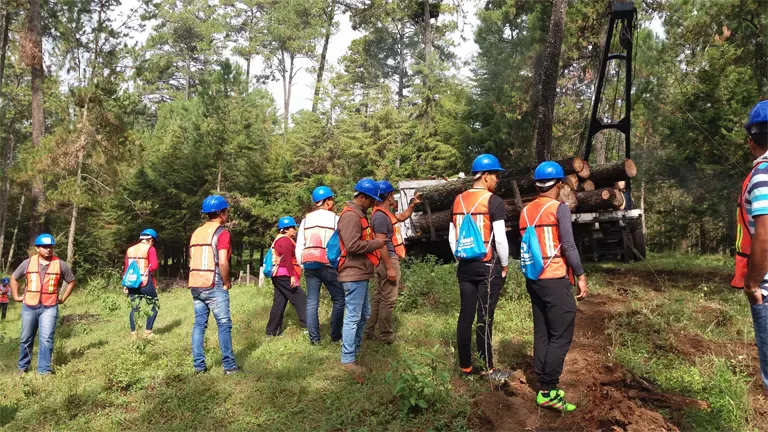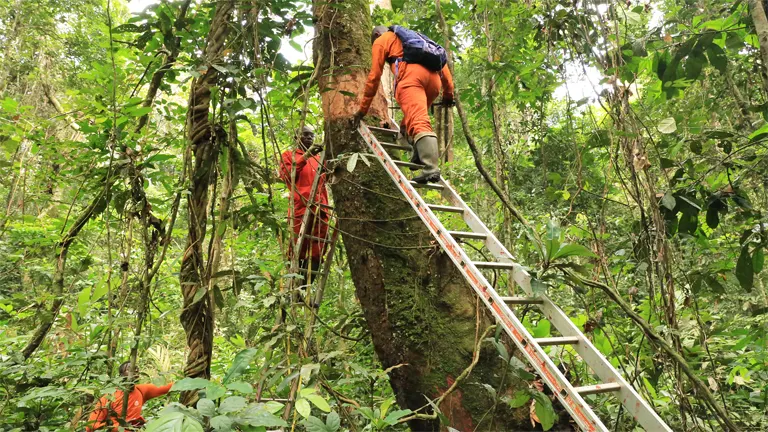5 Development of Forest Based Enterprises
- September 12, 2024
- 0 comment
The development of forest-based enterprises plays a vital role in promoting sustainable livelihoods, biodiversity conservation, and economic growth. As global efforts toward sustainability increase, forest-based enterprises have become an integral part of creating a balance between utilizing forest resources and preserving them for future generations.

These enterprises can range from timber production and non-timber forest products (NTFPs) to eco-tourism and forest-based services. In this article, we will explore the key aspects of forest-based enterprise development, the challenges they face, and their potential for contributing to both local economies and global sustainability.
List of 5 Development of Forest Based Enterprises:
- Types of Forest-Based Enterprises
- The Role of Indigenous and Local Communities
- Challenges in the Development of Forest-Based Enterprises
- Strategies for Promoting Forest-Based Enterprises
- The Role of Technology in Forest-Based Enterprises
Understanding About The Forest-Based Enterprises
Forest-based enterprises are businesses that rely on forest ecosystems for their primary resources. They can be divided into two broad categories: timber-based enterprises, which focus on the extraction and sale of wood products, and non-timber forest-based enterprises, which include a wide variety of goods and services such as medicinal plants, fruits, fibers, resins, and eco-tourism services.
Forest-based enterprises vary widely in size and scope, from small community-based operations to large-scale commercial ventures. Regardless of size, these enterprises can significantly impact both local and national economies by providing jobs, income, and opportunities for sustainable development.
Importance of Forest-Based Enterprises in Sustainable Development
Forest-based enterprises are critical to sustainable development for several reasons:
- Economic Benefits: Forest-based enterprises provide livelihoods for millions of people, especially in rural areas. By promoting local processing and value-added activities, these enterprises can enhance income generation and reduce poverty.
- Environmental Conservation: Properly managed forest enterprises can help in conserving biodiversity, protecting watersheds, and mitigating climate change. Sustainable forest management practices ensure that forest resources are not over-exploited, thus maintaining ecosystem balance.
- Social Development: In many regions, forest-based enterprises are community-driven and play a significant role in fostering social cohesion. Communities that rely on forest resources are often the best stewards of the land, ensuring the protection of forests while benefiting from them.
1. Types of Forest-Based Enterprises

Timber-Based Enterprises
- Timber extraction remains one of the most prominent forest-based enterprises. It includes the production of logs, lumber, plywood, and paper products. Sustainable forestry practices such as selective logging, reforestation, and certified timber production ensure that timber enterprises do not lead to deforestation or environmental degradation.
Non-Timber Forest Products (NTFPs)
- NTFPs include a wide range of products such as fruits, nuts, seeds, medicinal plants, mushrooms, resins, and natural fibers. These products can be harvested without destroying trees, making them an important component of sustainable forest management. NTFP-based enterprises can provide significant income for local communities, especially when they are processed and marketed effectively.
Eco-Tourism and Recreation Services
- Eco-tourism is a rapidly growing sector within forest-based enterprises. It involves offering tourists the opportunity to experience natural forest ecosystems while promoting conservation and environmental education. Eco-tourism can generate revenue while raising awareness about the importance of forest conservation.
2. The Role of Indigenous and Local Communities
Indigenous and local communities are often the primary custodians of forest ecosystems. They possess traditional knowledge and sustainable practices that have been passed down through generations. Empowering these communities through forest-based enterprises can lead to better forest management outcomes.

Supporting community-based forest enterprises involves recognizing and protecting indigenous land rights, providing access to markets, and facilitating capacity building. When local communities are involved in decision-making processes and benefit directly from forest resources, they are more likely to engage in sustainable practices.
3. Challenges in the Development of Forest-Based Enterprises
While forest-based enterprises offer significant opportunities, they also face numerous challenges that can hinder their development and sustainability:

- Access to Capital: Many small-scale forest enterprises lack access to financial resources, which limits their ability to invest in better technology, infrastructure, or market expansion. Addressing these financial constraints is essential for the growth of these enterprises.
- Market Access and Trade Barriers: Many forest-based enterprises, particularly those in remote areas, face difficulties in accessing markets. This can be due to poor infrastructure, lack of information about market trends, or trade barriers that limit their ability to export products.
- Capacity Building: Many communities and small-scale entrepreneurs lack the technical knowledge and skills required to manage forest resources sustainably and develop profitable businesses. Providing training and capacity-building programs is essential for improving their business operations.
- Sustainability Concerns: Forest degradation and deforestation pose significant threats to the long-term viability of forest-based enterprises. Unsustainable practices such as illegal logging and over-harvesting of NTFPs can lead to resource depletion, biodiversity loss, and environmental degradation.
4. Strategies for Promoting Forest-Based Enterprises
Governments, non-governmental organizations (NGOs), and the private sector play a critical role in supporting the development of forest-based enterprises. Some key strategies include:

- Promoting Sustainable Forest Management (SFM): SFM practices ensure that forests continue to provide economic, environmental, and social benefits without compromising their health. Certification schemes, such as those offered by the Forest Stewardship Council (FSC), encourage responsible forestry practices and provide market advantages to certified enterprises.
- Access to Finance and Investment: Creating financing mechanisms that cater specifically to forest-based enterprises can help them overcome financial constraints. Microfinance, grants, and loans with favorable terms can enable small-scale enterprises to invest in their operations and expand their market reach.
- Capacity Building and Training: Governments and NGOs can offer training programs that focus on improving business skills, sustainable harvesting techniques, product development, and marketing strategies. These initiatives can enhance the competitiveness and sustainability of forest-based enterprises.
- Market Linkages and Value Chain Development: Strengthening market linkages through cooperatives, producer groups, and partnerships with the private sector can help forest-based enterprises access larger markets and improve their profitability. Developing value chains that include processing and packaging can also increase the value of forest products.
- Supporting Policy Frameworks: Governments need to create policies that support the development of forest-based enterprises. This includes land tenure reforms, trade policies that favor forest products, and incentives for sustainable practices.
5. The Role of Technology in Forest-Based Enterprises
Advancements in technology are revolutionizing the way forest resources are managed and utilized. Technologies such as Geographic Information Systems (GIS), remote sensing, and drones are being used to monitor forest health, detect illegal logging activities, and optimize resource extraction. In addition, innovations in product processing, packaging, and marketing are helping forest-based enterprises reach new markets and increase their profitability.
E-commerce platforms are also enabling small-scale forest enterprises to market their products globally. By using digital platforms, enterprises can connect with consumers who are interested in sustainably sourced products, thus expanding their customer base.
Scenario Analysis: Successful Forest-Based Enterprises
To illustrate the potential of forest-based enterprises, let’s look at a few successful examples from around the world:
| Enterprise Type | Revenue Growth (%) | Employment Impact | Sustainability Rating | Key Challenges | Potential Solutions |
|---|---|---|---|---|---|
| Timber Enterprises | 8% annually | High (job creation) | Medium | Over-exploitation risks | Sustainable Forest Management (SFM) |
| Non-Timber Products | 12% annually | Moderate | High | Market access, product quality | Capacity building, value-added processing |
| Eco-Tourism | 15% annually | High | Very High | Infrastructure limitations | Investment in facilities, eco-certification |
- Community Forest Enterprises in Nepal: In Nepal, community forestry programs have empowered local communities to manage their forests sustainably. These programs have led to the development of enterprises based on NTFPs, such as essential oils and medicinal herbs, providing significant income to rural households.
- Bamboo Enterprises in India: In India, bamboo-based enterprises have emerged as a sustainable alternative to timber. Bamboo is used to produce a wide range of products, including furniture, handicrafts, and construction materials. These enterprises provide livelihoods to thousands of people while promoting the conservation of bamboo forests.
- Eco-Tourism in Costa Rica: Costa Rica has become a global leader in eco-tourism, with many forest-based enterprises offering nature-based tourism experiences. These enterprises generate revenue while promoting forest conservation and environmental education.
Future Prospects for Forest-Based Enterprises
The future of forest-based enterprises is promising, especially as global demand for sustainable products continues to rise. With the right support in terms of policy, finance, and capacity building, these enterprises can become key players in the green economy.
As more consumers and businesses prioritize sustainability, there is a growing market for eco-friendly products and services derived from forests. Forest-based enterprises that adopt sustainable practices and tap into this demand can thrive while contributing to environmental conservation.
Final Thoughts
The development of forest-based enterprises holds tremendous potential for promoting sustainable development, protecting biodiversity, and improving livelihoods. By fostering a balance between economic growth and environmental conservation, forest-based enterprises can contribute to a more sustainable and equitable future. However, achieving this potential requires overcoming challenges related to finance, market access, and sustainability, while empowering local communities and promoting the use of modern technologies.
Frequently Asked Questions (FAQs)
- What are forest-based enterprises?
Forest-based enterprises are businesses that derive their products or services from forest ecosystems, including timber, non-timber forest products, and eco-tourism services. - Why are forest-based enterprises important?
They promote sustainable livelihoods, biodiversity conservation, and economic growth, especially in rural areas. - What are non-timber forest products (NTFPs)?
NTFPs include items like medicinal plants, fruits, resins, and natural fibers harvested from forests without harming trees. - How do forest-based enterprises support sustainable development?
By balancing resource extraction with conservation efforts, they ensure forest ecosystems remain viable for future generations. - What role do local and indigenous communities play in forest-based enterprises?
These communities often manage forests sustainably and benefit from enterprises that leverage their traditional knowledge. - What challenges do forest-based enterprises face?
Major challenges include access to capital, market barriers, capacity building, and sustainability concerns. - How can governments support forest-based enterprises?
Through sustainable forest management policies, financial mechanisms, capacity building, and market access initiatives. - What is the impact of technology on forest-based enterprises?
Technologies like GIS, drones, and e-commerce improve resource management, marketing, and enterprise efficiency. - What are some examples of successful forest-based enterprises?
Examples include community forest enterprises in Nepal, bamboo enterprises in India, and eco-tourism in Costa Rica. - What is the future outlook for forest-based enterprises?
The future is promising, driven by the growing demand for sustainable products and the adoption of modern technologies.

James Wilson
Forestry AuthorJames Wilson has over 15 years of experience in forestry economics, specializing in sustainable practices, investment opportunities, and financial management. He has contributed to notable publications like "Forestry Today" and "EcoFinance Journal" and is known for providing practical and insightful advice. With a degree in Environmental Economics, James stays updated through continuous learning and active participation in industry discussions. Outside work, he enjoys hiking and nature photography, bringing a well-rounded perspective to his professional role.












Leave your comment